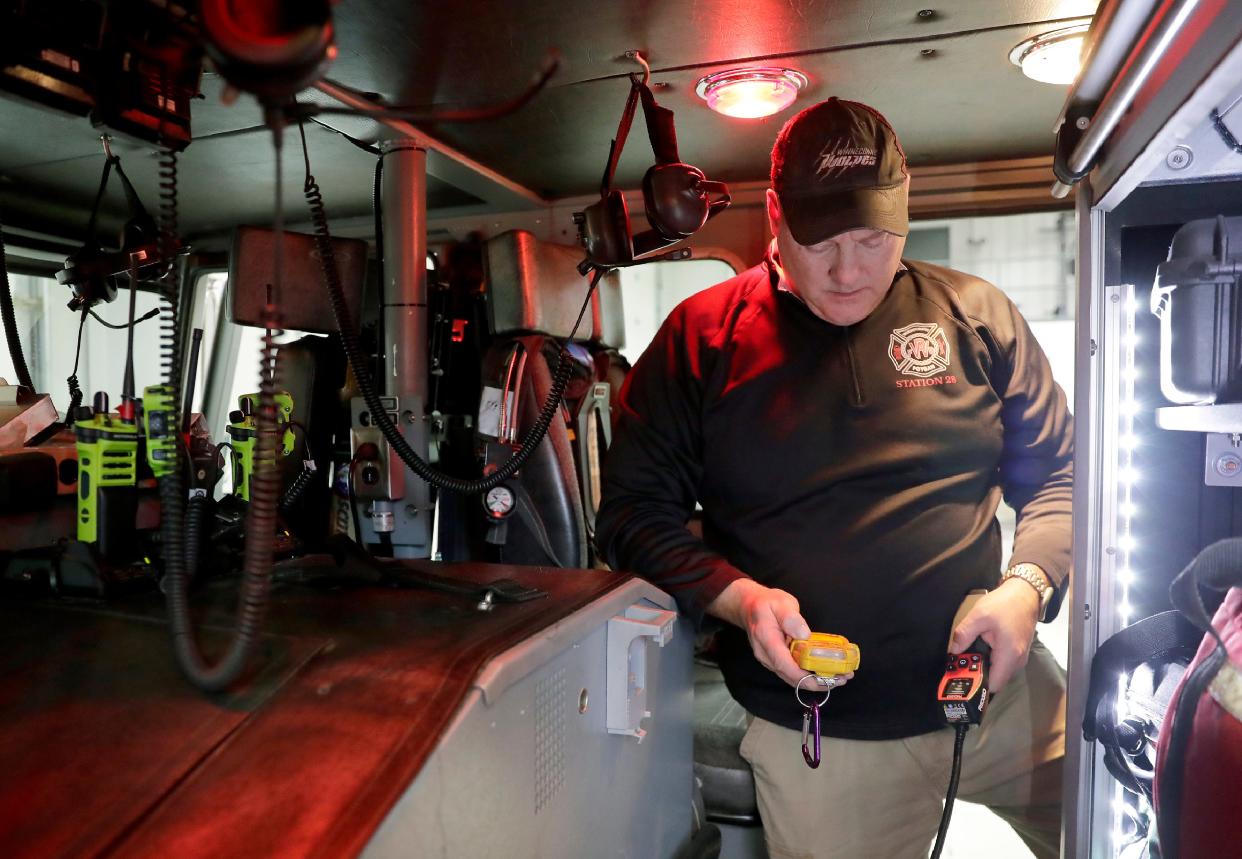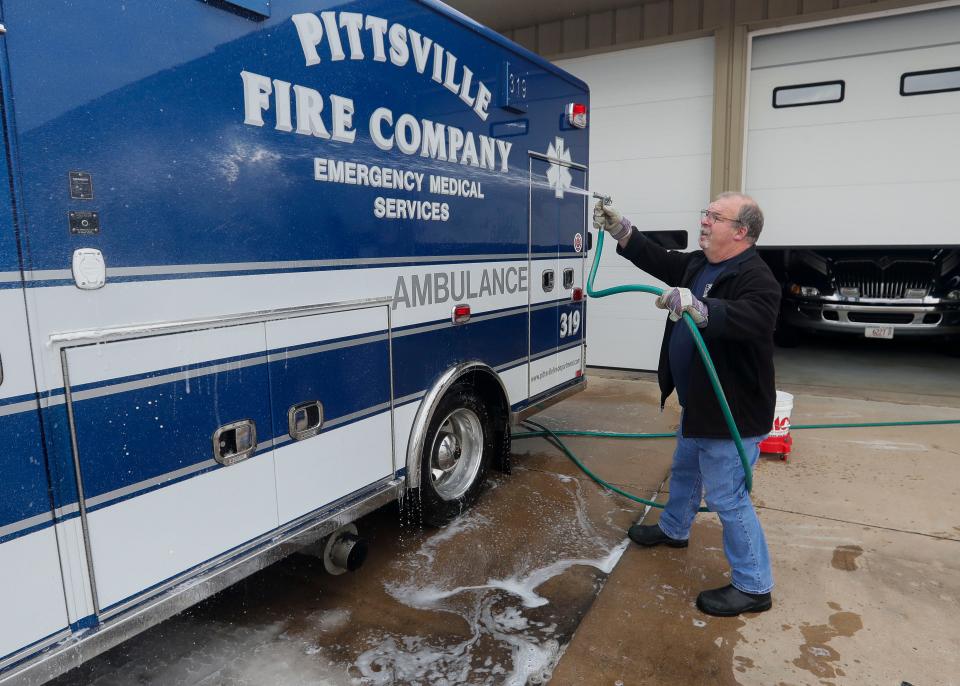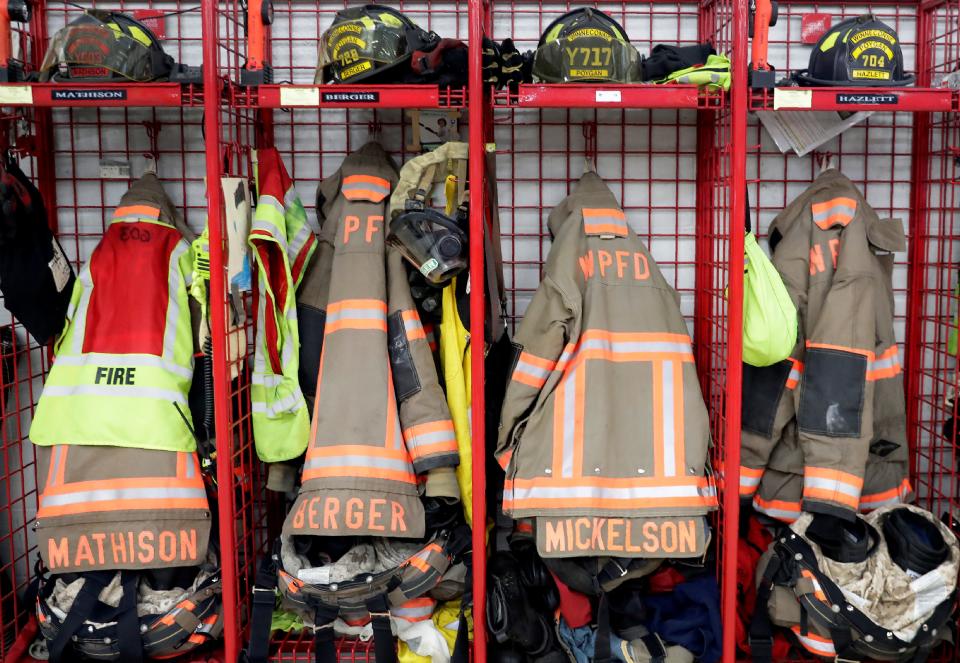It's getting tougher for volunteer fire departments in Wisconsin to find firefighters. That has an effect on the communities they serve

WINNECONNE - Ryan Krings is a busy man.
Not only does he have a full-time job as a firefighter with Neenah-Menasha Fire Rescue, where he works about 56 hours a week, but he's the volunteer chief of the Winneconne-Poygan Fire Department. Though Krings isn't paid as volunteer chief, he works about 20 hours a week there — on top of coaching football at the high school.
When Krings started work as a volunteer firefighter 32 years ago, 10 other people volunteered with him. Today, he said the department is lucky to get one new volunteer a year.
A full roster for the Winneconne-Poygan Fire Department, which protects the Village and Town of Winneconne and the Town of Poygan in Winnebago County, should be 62 volunteers. Right now, the department has 38. And although the station has all the necessary equipment to respond to fire emergencies, it often sits empty.
"Most of the time, if you come by here, the doors are locked and the lights are out," Krings said.
More than 92% of Wisconsin's 812 fire departments are volunteer or mostly volunteer according to the U.S. Fire Administration, ranking Wisconsin 14th nationally in that regard.
That means the challenges Krings encounters are playing out in nearly all fire departments across the state.
"In Need of Resuscitation," a Wisconsin Policy Forum study released at the end of 2021, details how many fire and emergency medical services (EMS) agencies are finding it tougher to operate each year as they face recruitment and retention difficulties — all while calls for emergency services are rising or staying steady. It's a problem that will only worsen as the population continues to age.
Fire departments across the state say it's been harder to find volunteers. The reasons vary. People are finding their extra time is stretched thin by full-time job and family commitments and decreasing flexibility allowed by their full-time employers. And many local governments aren't able to fund additional positions or stipends because of state limits on spending.
Rob Henken, president of the Wisconsin Policy Forum, a nonprofit and nonpartisan think tank, helped write the report about the state's looming challenges of fire and EMS agencies in the state. The think tank forum has been reviewing some of the issues facing these emergency departments for eight years. But recently, the issues have neared a breaking point.
"The challenges are getting more and more severe," Henken said. "Based on that severity, there are beginning to be some implications for public safety."
Most of the data was collected before the COVID-19 pandemic, meaning the situation — an increase in medical calls, staff shortages — has only gotten worse.
Every second counts, but less staffing means response time can be slowed
Some 85 miles northwest of the Winneconne-Poygan fire station is another small-town fire station operating below capacity.
In Vesper, a village of about 600 in Wood County, Chief Dennis Dederich has about 28 volunteers on his roster. When asked how many he really needed, Dederich said he would like “almost any number north of there.”
He has seen numbers drop in a slow progression to where they are today.
“Back 20 years ago, there were all sorts of predictions that the volunteer fire departments after September 11 were going to be flooded with civic-minded applicants,” Dederich said.
That didn't happen.
Instead, he saw the opposite unfold, with a gradual decline in members of the community looking to join the department.
He has noticed that, as fewer people in the area work close to home and have more travel time, they have less time for anything other than family commitments, particularly people with young families.
“We have several members now with kids that are in preschool and grade school, and their time gets stretched pretty thin,” Dederich said.
That also affects the number of people who can actually respond to calls when they go out.
It’s a good thing, he said, “to have nice roster numbers, but it's more important to have people that are available.”

In nearby Pittsville, a city of 874 that calls itself the "geographic center" of the state, Chief Jerry Minor has 27 people on his roster and needs 36. One issue that worries him is that the people on his roster are getting older.
“It started as kind of a joke,” says Minor, but on a recent fire call, his department added up the average age of everyone on the call and found that it was 58.
One of the things he said stands in the way of getting younger recruits with tight schedules may be the lack of flexibility from employers.
Minor said, in the past, local employers were more likely to allow employees to change their schedule to be available for calls — allowing them to come in late or leave occasionally — than they have been in the past.
Now he says, “that’s almost nonexistent.”
The lack of staffing means the department is often calling for assistance from other departments that are farther and farther away — making it harder to arrive at sites quickly and with enough people to handle emergencies.
“We’re kind of in a business where every tick of the clock, things are getting a lot worse,” Dederich said.
For advanced emergency medicine, the wait can be longer
Because seconds matter when responding to an emergency, the first responder's level of training is crucial — and not every volunteer is required to have the same level of training.
For example, there are four different levels of EMS licenses: Emergency Medical Responder, Emergency Medical Technician (EMT), Advanced EMT and Paramedic. Emergency medical responders require the least amount of training and are only able to provide noninvasive first-aid techniques such as chest compressions, checking blood pressure, heart rate and oxygen levels and applying pressure to control bleeding.
In contrast, paramedics, who have the highest level of training, can administer the largest amount of medications.
The majority of fire department volunteers are trained as firefighters and not EMS. Krings said emergency medical responders not only require more training than firefighters but they have to be nationally registered and licensed on top of needing to re-certify every few years. Firefighters, on the other hand, only have to be certified once.
For these reasons, many fire departments in the state are only able to provide basic life-support services, leaving advanced life support and ambulance transport to a different agency, according to the Wisconsin Policy Forum.
In fact, 35% of Wisconsin fire departments don't transport patients to hospitals, according to data from the U.S. Fire Administration.
The Winneconne-Poygan Fire Department is one of them.
Emergency medical services — not fires — make up 82% of the department's calls but most of its volunteers are trained as emergency medical responders, meaning they can only provide the most basic level of care.
Krings said the department often can't give much help until the "Oshkosh (Fire Department) gets there."
Two members of Krings' department are training as emergency medical technicians, a level higher than an emergency medical responder. When their training is complete, they'll be able to perform invasive medical techniques like tracheotomies, administer oxygen and provide medications like Narcan for opioid overdoses.
Krings said two of the volunteers are training to be paramedics, but once they reach that highest level of certification, they both plan to seek full-time jobs elsewhere.
Winneconne-Poygan is one of 10 local volunteer agencies that contract with the Oshkosh Fire Department for paramedic services.
If a municipality like Winneconne or Omro gets a medical call, the Oshkosh fire department automatically gets the call, too. It then sends out an ambulance and can take the patient to the hospital, if needed.
Jay Treleven, fire chief with the Omro-Rushford department, said it uses this "Cadillac service" frequently. Annually, it's averaging 130 fire calls compared to 350 to 400 EMS calls.
But EMS calls in Oshkosh itself are also rising, now accounting for 75-80% of the department's calls, a 5.5% increase from 2020 to 2021.
Heinken said the trends of an aging population, more EMS calls and dwindling volunteers are problematic, especially in smaller communities.
"Our call volume is not decreasing," Krings said. "We’re taking in less amount of people on staff and taking more calls."
Mike Stanley, Oshkosh's fire chief, said the issue of ensuring a quick response time is fundamental to the fire department and EMS services: the longer a fire is burning, the worse it gets. But a fast response time can be harder to achieve when there is a larger distance.
"I can get across the street a lot faster than I can get to Rushford," Stanley said.
Mutual-aid agreements allow fire departments to help each other
Just as the Oshkosh Fire Department contracts with 10 smaller departments to provide emergency medical services, other departments do the same through a variety of options that have only been necessitated in the past 25 years.
Mutual aid agreements and consolidation are ways Wisconsin departments have met the needs of their communities. So is the Mutual Aid Box Alarm System (MABAS), a regional emergency communication system first used in 2006.
The system alerts other departments to a call in a neighboring municipality if they need assistance by filling out a "box card" that details the emergency and what assistance they need.
But not all emergencies trigger a box alarm response.
Mark Jansen, volunteer chief of Little Chute's fire department, pointed to a large grass fire along Interstate 41 in Appleton a few years ago as an example. That fire didn't trigger a box alarm response, but a major pileup on I-41 between Neenah and Oshkosh in 2019 did.
To bridge the gaps in emergency responses, fire departments in Outagamie County began working on a mutual aid pact two years ago.
The result is a new Outagamie County Mutual Aid Pact between 15 fire departments, covering 23 municipalities across the county. It's the first time there's been a county-wide agreement, an accomplishment the one chief calls "a rarity."
"It's been done before, but we thought if we worked on it proactively, it is a good way to get out of a jam," said Gregory Brown, volunteer chief of the Seymour Fire Department. "It is somewhat of a rarity to have a county-wide mutual aid pact."
According to Jansen, this mutual aid pact is for smaller incidents where a special piece of equipment may be needed. And, instead of creating individual mutual aid requests for different pacts, they would just make one for the county-wide pact.
Examples of its use could include car accidents that occur on roads between municipalities and fire department borders and incidents that require additional resources but don't rise to any MABAS levels and staffing needs.
"It's filling the gaps," Jansen said.
The Appleton and Kaukauna fire departments decided not to join the Outagamie Mutual Aid Pact, instead deciding to stick with their current mutual aid agreements.
Chiefs from both departments also cited the box alarm system as another reason they don't need to be part of the county-wide mutual aid pact.
"I think the mutual aid pact is good. I think it's necessary," said Jake Carrel, chief of Kaukauna's fire department. "It shows good cooperation amongst many departments in the Outagamie area."

There are solutions for volunteer fire departments, but none of them are easy
As fire departments across the state are working to ensure residents get the best service possible, there's not one easy fix to keep their rosters of first responders full.
Volunteers at the Winneconne-Poygan Fire Department do get a yearly $500 stipend, which is "nothing, basically," Krings said.
Some departments are using a combination model of volunteers and some part-time staff in a model called "paid-on-premise."
In this model, a department could hire some firefighters during the day to work at the station and pay them. Volunteer firefighters would be on call at night, often responding from their home.
This could be a possible solution, Henken said, but it might not necessarily fix some of the underlying issues of funding for departments.
Fire and EMS funding is almost entirely local, with little support from state or federal governments. A Wisconsin Policy Forum study from January 2021 found spending on fire services is below the national average, with per capita spending coming in at 31st out of the 50 states.
Staffing numbers for volunteer departments also differ throughout the state. Ron Carpenter, assistant fire chief for Omro-Rushford Fire Department, said it's "fortunate" to have a big staff of 57 volunteers.
And finding staff remains a problem, partly due to time costs.
Carpenter, who works full time at a different job, said one year he tracked how much time he spent at the department before he was assistant chief. It added up to 200 volunteer hours.
He knows that number can be daunting to potential volunteers.
"You tell someone they gotta volunteer 200 hours, where are you going to put your five weeks?" Carpenter said.
While there are certainly potential, smaller fixes to alleviate some concerns, there is no "silver bullet," Wisconsin Policy Forum's Henken said.
"The overriding warning ... is that this problem across the state has grown to sufficient severity that it really does demand some pretty intensive and immediate policy considerations," Henken said. "And not just at the local level — because there are so many (tax levy) restrictions — but also at the state level."
As for Krings, he told the Winneconne-Poygan Fire Department's board he would retire in five years. Although there may be some people at the station interested in his position, Krings warned the board they might have to hire a full-time chief.
Krings knows the future of the fire department has a lot of questions, but he's staying hopeful.
"It’s going to be a long row to hoe," Krings said. "Luckily I’m not the only one that has to deal with it. There’s a lot of other people out there putting their minds to it and trying to figure this out."
Contact Bremen Keasey at 920-570-5614 or bkeasey@gannett.com. Follow him on Twitter at @Keasinho.
Contact Roshaun Higgins at 920-205-1154 or rhiggins@gannett.com. Follow him on Twitter at @row_yr_boat.
Renee Hickman is a Report For America corps member based at the Wausau Daily Herald covering rural issues in Wisconsin. Contact at rhickman@gannett.com or follow her on Twitter at @ReneeNHickman.
This article originally appeared on Oshkosh Northwestern: Wisconsin's volunteer fire department struggling to find firefighters

